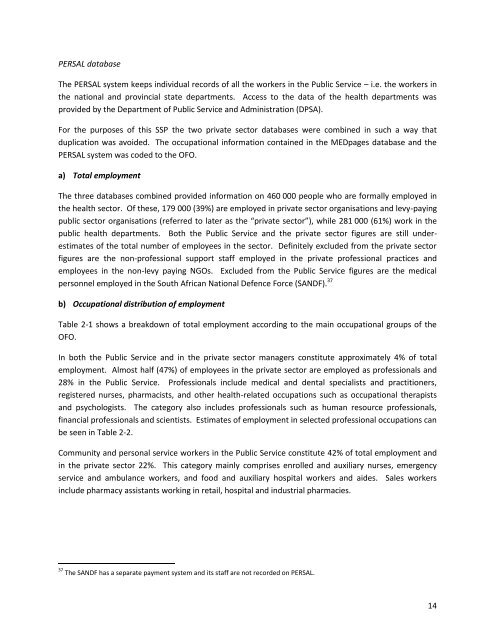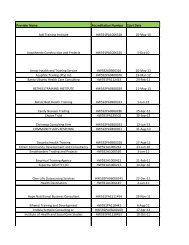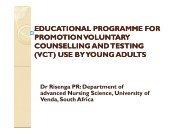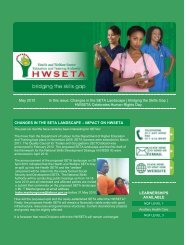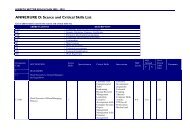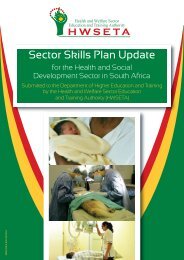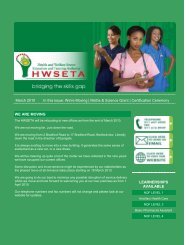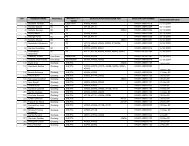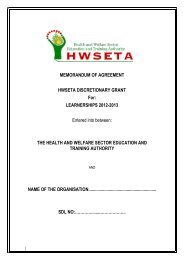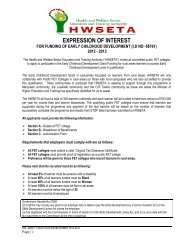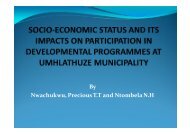sector skills plan for the health sector in south africa
sector skills plan for the health sector in south africa
sector skills plan for the health sector in south africa
You also want an ePaper? Increase the reach of your titles
YUMPU automatically turns print PDFs into web optimized ePapers that Google loves.
PERSAL database<br />
The PERSAL system keeps <strong>in</strong>dividual records of all <strong>the</strong> workers <strong>in</strong> <strong>the</strong> Public Service – i.e. <strong>the</strong> workers <strong>in</strong><br />
<strong>the</strong> national and prov<strong>in</strong>cial state departments. Access to <strong>the</strong> data of <strong>the</strong> <strong>health</strong> departments was<br />
provided by <strong>the</strong> Department of Public Service and Adm<strong>in</strong>istration (DPSA).<br />
For <strong>the</strong> purposes of this SSP <strong>the</strong> two private <strong>sector</strong> databases were comb<strong>in</strong>ed <strong>in</strong> such a way that<br />
duplication was avoided. The occupational <strong>in</strong><strong>for</strong>mation conta<strong>in</strong>ed <strong>in</strong> <strong>the</strong> MEDpages database and <strong>the</strong><br />
PERSAL system was coded to <strong>the</strong> OFO.<br />
a) Total employment<br />
The three databases comb<strong>in</strong>ed provided <strong>in</strong><strong>for</strong>mation on 460 000 people who are <strong>for</strong>mally employed <strong>in</strong><br />
<strong>the</strong> <strong>health</strong> <strong>sector</strong>. Of <strong>the</strong>se, 179 000 (39%) are employed <strong>in</strong> private <strong>sector</strong> organisations and levy-pay<strong>in</strong>g<br />
public <strong>sector</strong> organisations (referred to later as <strong>the</strong> “private <strong>sector</strong>”), while 281 000 (61%) work <strong>in</strong> <strong>the</strong><br />
public <strong>health</strong> departments. Both <strong>the</strong> Public Service and <strong>the</strong> private <strong>sector</strong> figures are still underestimates<br />
of <strong>the</strong> total number of employees <strong>in</strong> <strong>the</strong> <strong>sector</strong>. Def<strong>in</strong>itely excluded from <strong>the</strong> private <strong>sector</strong><br />
figures are <strong>the</strong> non-professional support staff employed <strong>in</strong> <strong>the</strong> private professional practices and<br />
employees <strong>in</strong> <strong>the</strong> non-levy pay<strong>in</strong>g NGOs. Excluded from <strong>the</strong> Public Service figures are <strong>the</strong> medical<br />
personnel employed <strong>in</strong> <strong>the</strong> South African National Defence Force (SANDF). 37<br />
b) Occupational distribution of employment<br />
Table 2-1 shows a breakdown of total employment accord<strong>in</strong>g to <strong>the</strong> ma<strong>in</strong> occupational groups of <strong>the</strong><br />
OFO.<br />
In both <strong>the</strong> Public Service and <strong>in</strong> <strong>the</strong> private <strong>sector</strong> managers constitute approximately 4% of total<br />
employment. Almost half (47%) of employees <strong>in</strong> <strong>the</strong> private <strong>sector</strong> are employed as professionals and<br />
28% <strong>in</strong> <strong>the</strong> Public Service. Professionals <strong>in</strong>clude medical and dental specialists and practitioners,<br />
registered nurses, pharmacists, and o<strong>the</strong>r <strong>health</strong>-related occupations such as occupational <strong>the</strong>rapists<br />
and psychologists. The category also <strong>in</strong>cludes professionals such as human resource professionals,<br />
f<strong>in</strong>ancial professionals and scientists. Estimates of employment <strong>in</strong> selected professional occupations can<br />
be seen <strong>in</strong> Table 2-2.<br />
Community and personal service workers <strong>in</strong> <strong>the</strong> Public Service constitute 42% of total employment and<br />
<strong>in</strong> <strong>the</strong> private <strong>sector</strong> 22%. This category ma<strong>in</strong>ly comprises enrolled and auxiliary nurses, emergency<br />
service and ambulance workers, and food and auxiliary hospital workers and aides. Sales workers<br />
<strong>in</strong>clude pharmacy assistants work<strong>in</strong>g <strong>in</strong> retail, hospital and <strong>in</strong>dustrial pharmacies.<br />
37 The SANDF has a separate payment system and its staff are not recorded on PERSAL.<br />
14


